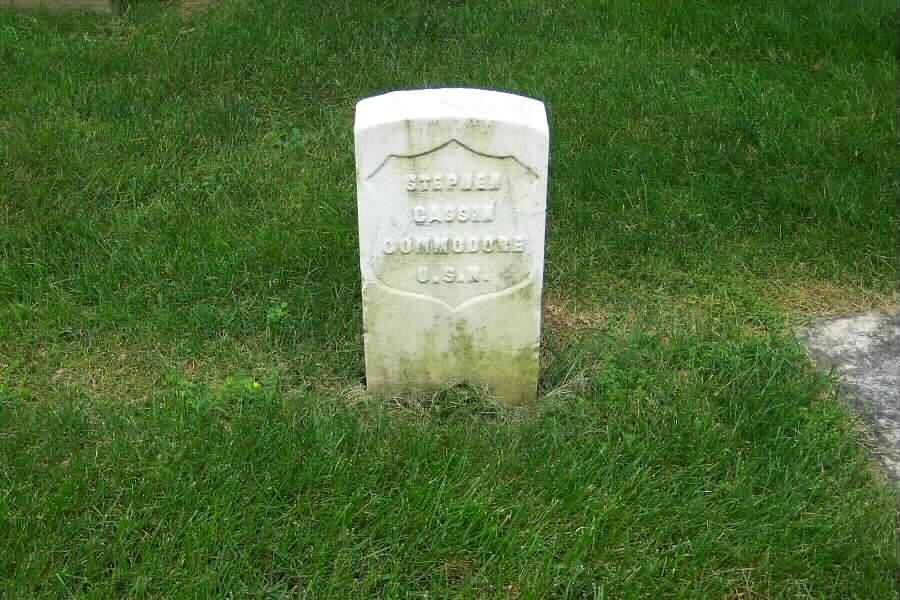Stephen Cassin (16 February 1783 – 29 August 1857) was an officer in the United States Navy.
Born in Philadelphia, the son of naval officer John Cassin, Cassin entered the United States Navy as a midshipman in 1800, and served in Philadelphia in the West Indies during the latter part of the war with France. In the War of 1812, he commanded USS Ticonderoga in the Battle of Lake Champlain and was awarded a gold medal for bravery by the United States Congress. He later served during the Second Barbary War in Peacock.
Captain Cassin died in Washington, D.C.. He was buried in Washington, but later moved to Arlington National Cemetery.
Text of Congressional Gold Medal resolution:
“Resolved, That the President of the United States be requested to cause gold medals to be struck, emblematical of the action between the two squadrons, and to present them to Captain Macdonough and Captain Robert Henley, and also to Lieutenant Stephen Cassin, in such manner as may be most honourable to them; and that the President be further requested to present a silver medal, with suitable emblems and devices, to each of the commissioned officers of the navy and army serving on board, and a sword to each of the midshipmen and sailing masters, who so nobly distinguished themselves in that memorable conflict.”
Two ships have been named USS Cassin for him.
Born at Philadelphia on February 16, 1783, the son of a prominent Naval officer.
He was appointed Midshipman, February 1800 and served well in the Tripolian War and advanced to Lieutenant in February 1807.
In 1812, he was ordered to Lake Champlain where Lieutenant Thomas Macdonough was engaged in building a fleet with which to oppose a British advance from Canada.
In the Battle of Lake Champlain, September 11, 1814, Cassin, who was that day promoted Master Commandant, commanded the sloop Ticonderoga, 17 guns, the third heaviest ship in the Navy. His gallant performance in the battle – fighting off many assaults and boarding attempts while exposing himself to heavy fire – was credited by later naval historians with contributing greatly, perhaps decisively, to victory on that day.
He was granted a Gold Medal by Congress, October 1814.
He won further renown in 1822 while on pirate patrol aboard the sloop Peacock, 18 guns, in West Indian waters. On September 28-30 alone he captured five pirate craft. The next year, commanding a small squadron off the northern coast of Cuba, he captured or destroyed several more.
He was promoted to Captain in March 1825 and to Commodore in 1830. He died in Georgetown, D.C. on August 29, 1857. He had been chosen to carry the captured battle flags from the conflict on Lake Champlain to Washington. His father, John Cassin, was a Navy Commander in the American Revolution.
He was buried elsewhere in Washington and was subsequently moved to Section 1 of Arlington National Cemetery.
NOTE: A distant relative, Thomas Cassin Kinkaid, Admiral, United States Navy, is also buried in Arlington National Cemetery.
September 1, 1857 – Commodore Stephen Cassin died at his residence in Georgetown, D.C. on Saturday in the 70th year ofhis age. He entered theNavy fifty-seven years ago, when a boy and served under Perry at the naval battle of Lake Erie, where he distinguished himself, and was promoted. He was a terror to the pirates who infested the Atlantic Ocean and on the 28th and 29th of September 1822, he captured five pirate vessels. He also commanded the Ticonderoga, under Commodore McDonough, on Lake Chaplain in 1814. In consequence of ill health he had seen but eleven years’ sea service and was on the reserved list at the time of his death.
CASSIN, STEPHEN
- COMMODORE US NAVY
- DATE OF DEATH: 08/29/1857
- BURIED AT: SECTION W.DIV SITE LOT 299
- ARLINGTON NATIONAL CEMETERY
CASSIN, MARGARET W/O STEPHEN
- DATE OF DEATH: 06/14/1830
- BURIED AT: SITE LOT 298
- ARLINGTON NATIONAL CEMETERY
Michael Robert Patterson was born in Arlington and is the son of a former officer of the US Army. So it was no wonder that sooner or later his interests drew him to American history and especially to American military history. Many of his articles can be found on renowned portals like the New York Times, Washingtonpost or Wikipedia.
Reviewed by: Michael Howard

